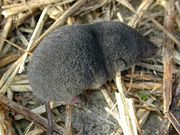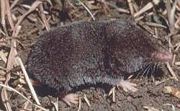Shrew
| Shrews[1] Fossil range: Middle Eocene–Recent |
||||||||||
|---|---|---|---|---|---|---|---|---|---|---|
 Southern Short-tailed Shrew
|
||||||||||
| Scientific classification | ||||||||||
|
||||||||||
| Subfamilies | ||||||||||
|
Crocidurinae |
Shrews are small, superficially mouse-like mammals of the family Soricidae. Although their external appearance is generally that of a long-nosed mouse, the shrews are not rodents and not closely related: the shrew family is part of the order Soricomorpha. Shrews have feet with five clawed toes, unlike rodents, which have four. Shrews are also not to be confused with either treeshrews or elephant shrews, which belong to different orders.
Shrews are distributed almost worldwide: of the major temperate land masses, only New Guinea, Australia, and New Zealand do not have native shrews at all; South America has shrews only in the far-northern tropics, including Colombia. In terms of species diversity, the shrew family is the fourth most successful of the mammal families, being rivalled only by the muroid families Muridae and Cricetidae and the bat family Vespertilionidae.
Contents |
Characteristics
All shrews are small, most no more than mouse size. The largest species is the House Shrew (Suncus murinus) of tropical Asia which is about 15 cm long and weighs around 100 grams; several are very small, notably the Etruscan Shrew (Suncus etruscus) which at about 3.5 cm and 2 grams is the smallest living terrestrial mammal.
In general, shrews are terrestrial creatures that forage for seeds, insects, nuts, worms and a variety of other foods in leaf litter and dense vegetation, but some specialise in climbing trees, living underground, in the subniveal layer or even hunting in water. They have small eyes, and generally poor vision, but have excellent senses of hearing and smell.[2] They are very active animals, with voracious appetites and unusually high metabolic rates. Shrews must eat 80-90 % of their own body weight in food daily. They are not able to hibernate, however shrews are capable of Torpor.
Whereas rodents have gnawing incisors that grow throughout life, the teeth of shrews wear down throughout life, a problem made more extreme by the fact that they lose their milk teeth before birth, and therefore have only one set of teeth throughout their lifetime. Apart from the first pair of incisors, which are long and sharp, and the chewing molars at the back of the mouth, the teeth of shrews are small and peg-like, and may be reduced in number. The dental formula of shrews is:
| 3.1.1-3.3 |
| 1-2.0-1.1.3 |
Shrews are fiercely territorial, driving off rivals, and only coming together to mate. Many species dig burrows for caching food and hiding from predators, although this is not universal.[2].
Female shrews can have up to ten litters a year, and the animals only stop breeding in the winter in temperate zones, and breed all year round in the tropics. Shrews have a gestation period of 17–32 days. The female often becomes pregnant within a day or so of giving birth, and lactates during her pregnancy, weaning one litter as the next is born[2]. Shrews live for between 12 and 30 months.[3]
Shrews are unusual among mammals in a number of respects. Unlike most mammals, some species of shrew are venomous. Also, along with the bats and toothed whales, some species of shrew use echolocation. Unlike most other mammals, shrews lack a zygomatic bone (also called the jugal), and therefore have an incomplete zygomatic arch.
Shrews hold nearly 10% of their mass in their brain, a relatively high brain to body mass ratio.[4]
Echolocation

The only terrestrial mammals known to echolocate are two genera (Sorex and Blarina) of shrews and the tenrecs of Madagascar. These include the Vagrant Shrew (Sorex vagrans), the Common or Eurasian Shrew (Sorex araneus), and the Northern Short-tailed Shrew (Blarina brevicauda). The shrews emit series of ultrasonic squeaks. In contrast to bats, shrews probably use echolocation to investigate their habitat rather than to pinpoint food.
Classification
There are 376 species of shrew in 26 genera, which are grouped into three living subfamilies: Crocidurinae (white-toothed shrews), Myosoricinae (African white-toothed shrews) and Soricinae (red-toothed shrews). In addition, the family contains the extinct subfamilies Limnoecinae, Crocidosoricinae, Allosoricinae and Heterosoricinae (although Heterosoricinae is also commonly considered a separate family).
- Family Soricidae
- Subfamily Crocidurinae
- Crocidura
- Diplomeson
- Feroculus
- Paracrocidura
- Ruwenzorisorex
- Scutisorex
- Solisorex
- Suncus
- Sylvisorex
- Subfamily Myosoricinae
- Congosorex
- Myosorex
- Surdisorex
- Subfamily Soricinae
- Tribe Anourosoricini
- Anourosorex
- Tribe Blarinellini
- Blarinella
- Tribe Blarinini
- Blarina
- Cryptotis
- Tribe Nectogalini
- Chimarrogale
- Chodsigoa
- Episoriculus
- Nectogale
- Neomys
- Nesiotites
- Soriculus
- Tribe Notiosoricini
- Megasorex
- Notiosorex
- Tribe Soricini
- Sorex
- Tribe Anourosoricini
- Subfamily Crocidurinae
Metaphorical usage
In the English language, the word shrew is also used to describe a woman with a violent, scolding, or nagging temperament, as in Shakespeare's play The Taming of the Shrew. The animals were believed historically to behave aggressively and with cruelty, and to have a poisonous bite; the term "shrew" was then applied to a person thought to have a similar disposition.[5]
Shrew was one of the names originally proposed for the British Fighter Airplane which finally became known as the Spitfire and played a key role in the Second World War.
References
- ↑ Hutterer, Rainer (2005-11-16). Wilson, D. E., and Reeder, D. M. (eds). ed.. Mammal Species of the World (3rd edition ed.). Johns Hopkins University Press. pp. 223-300. ISBN 0-801-88221-4. http://www.bucknell.edu/msw3.
- ↑ 2.0 2.1 2.2 Barnard, Christopher J. (1984). Macdonald, D.. ed.. The Encyclopedia of Mammals. New York: Facts on File. pp. 758-763. ISBN 0-87196-871-1.
- ↑ Macdonald (Ed), Professor David W. (2006). The Encyclopedia of Mammals. Oxford University Press. ISBN 0-19-920608-2.
- ↑ Brains of White Matter
- ↑ Stefan Buczacki, Fauna Britannica, 2002, ISBN 0-600-61392-5
- Buchler, E.R. 1973. The use of echolocation by the wandering shrew, Sorex vagrans Baird. Diss. Abstr. Int. B. Sci. Eng. 33(7): 3380-3381.
- Buchler, E.R. 1976. Experimental demonstration of echolocation by the wandering shrew (Sorex vagrans). Anim. Behav. 24(4): 858-873.
- Busnel, R.-G. (Ed.). 1963. Acoustic Behaviour of Animals. Amsterdam: Elsevier Publishing Company.
- Forsman, K.A., Malmquist, M.G. 1988. Evidence for echolocation in the common shrew, Sorex araneus. J. Zool., Lond. 216 (4): 655-663. .
- Gould, E. 1962. Evidence for echolocation in shrews.Ph.D. Thesis, Tulane University.
- Gould, E., Negus, N., Novick, A. 1964. Evidence for echolocation in shrews. J. Exp. Zool. 156: 19-38.
- Hutterer, R. 1976. Deskriptive und vergleichende Verhaltensstudien an der Zwergspitzmaus, Sorex minutus L., und der Waldspitzmaus, Sorex araneus L. (Soricidae - Insectivora - Mammalia). Unpublished Ph.D. Thesis, Univ. Wien.
- Hutterer, R., Vogel., P. 1977. Abwehrlaute afrikanischer Spitzmäuse der Gattung Crocidura Wagler, 1832 und ihre systematische Bedeutung. Bonn. Zool. Beitr. 28(3/4): 218-227.
- Hutterer, R., Vogel, P., Frey, H., Genoud, M. 1979. Vocalization of the shrews Suncus etruscus and Crocidura russula during normothermia and torpor. Acta Theriol. 24(21): 267-271.
- Irwin, D.V., Baxter, R.M. 1980. Evidence against the use of echolocation by Crocidura f. flavescens (Soricidae). Säugetierk. Mitt. 28(4): 323.
- Kahmann, H., Ostermann, K. 1951. Wahrnehmen und Hervorbringen hoher Töne bei kleinen Säugetieren. Experientia 7(7): 268-269.
- Köhler, D., Wallschläger, D. 1987. Über die Lautäußerungen der Wasserspitzmaus, Neomys fodiens (Insectivora: Soricidae). Zool. Jb. Physiol. 91: 89-99.
- Sales, G., Pye, D. 1974. Ultrasonic communication by animals. London.
- Tomasi, T.E. 1979. Echolocation by the short-tailed shrew Blarina brevicauda. J. Mammalogy 60(4): 751-759.